Table of Contents
When most brands say they’re “performance-first,” they usually mean more ads = more leads.
But here’s the truth: scaling acquisition isn’t about spending more—it’s about spending right.
At The Brisk, we’ve always believed performance is a science of decisions. This case study outlines how we helped an emerging direct-to-consumer brand slash CAC by 60%—not with bigger budgets, but with a smarter, calibrated multi-channel strategy rooted in media mix modeling.
Let’s break down the real-world challenge, the framework we deployed, and the measurable impact that followed.
The Problem: Rising CAC, Stagnant Conversions
Our client: A high-growth skincare D2C brand targeting urban millennials across India.
The context:
- 3 hero products across hair fall and acne categories
- Performance heavily reliant on Meta Ads
- Avg. CAC in Q1 2024: ₹1,258
- ROAS declining month-over-month
The signs of media fatigue:
- Frequency on Meta: 8.4+
- CTRs dropped below 0.7%
- Retargeting audiences saturated
- AOV flatlined despite product bundling
Despite a healthy ad spend (~₹15L/month), conversions weren’t scaling and CAC was climbing. They were stuck in the Meta-Google loop—and bleeding efficiency.
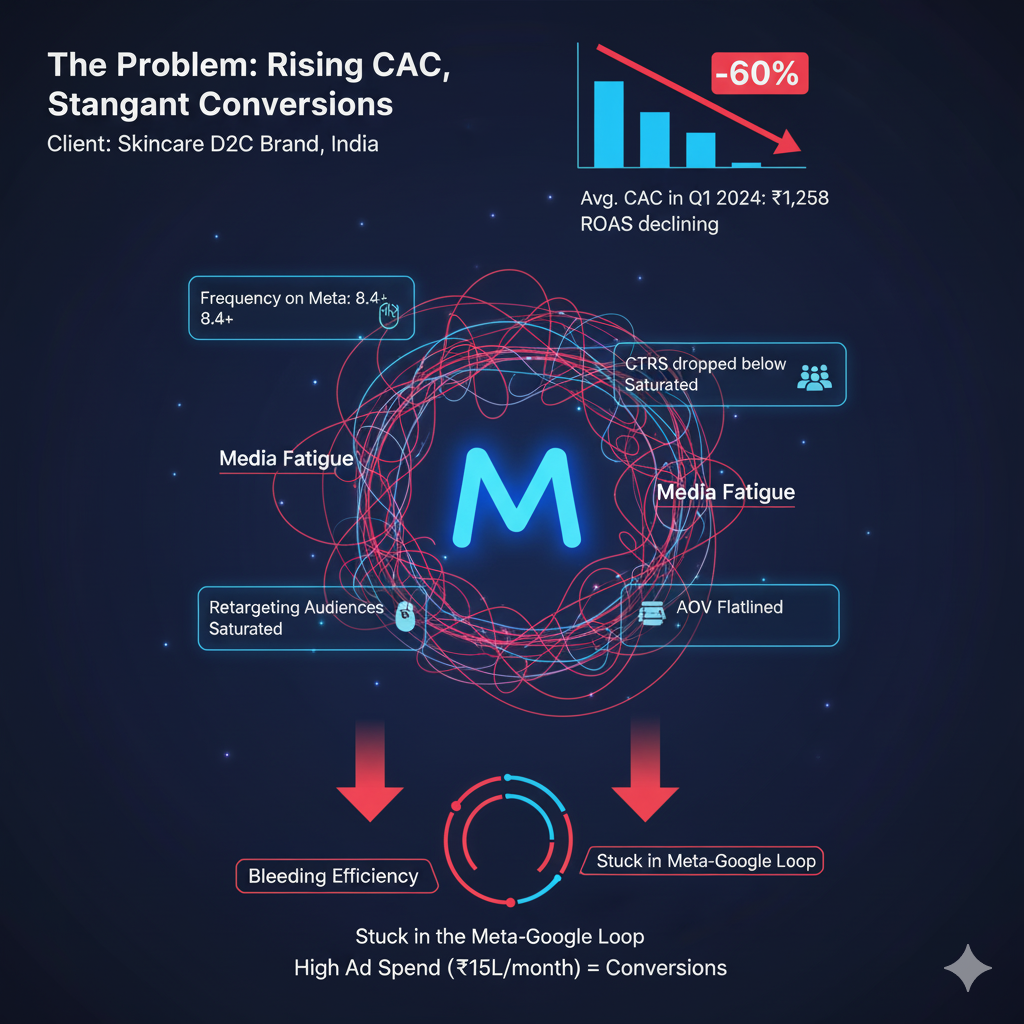
🧠 Our Strategy: Build a Multi-Channel Engine with Data-Led Media Mix
We didn’t just shift platforms—we rewired the strategy from ground up using three guiding pillars:
1. 🔍 Diagnose: Channel Contribution via Media Mix Modeling (MMM)
Goal: Understand which channel actually drives revenue (not just leads).
We ran a 6-month regression-based MMM using:
- Spend across channels (Meta, Google, YouTube, Email, Influencers, Retargeting)
- Assisted conversion paths (via GA4 + post-purchase surveys)
- Time-lag attribution (first-click vs last-click vs linear)
📊 Finding:
Meta and Google were over-attributed.
Influencers + Email + Organic combined drove 38% of bottom-funnel conversions, yet got only 12% of spend.
2. 🚀 Reallocate: Precision Budgeting Based on Funnel Impact
We built a new media mix model segmented by funnel stages:
| Funnel Stage | Channel | Budget Share (Before) | Budget Share (After) |
| TOFU | Meta, Influencers | 60% | 40% |
| MOFU | YouTube, Native Ads | 10% | 25% |
| BOFU | Google Search, Email | 30% | 35% |
We moved aggressively into:
- Influencer micro-campaigns (₹5–10K budgets, niche creators)
- YouTube video explainers with clear CTAs
- Email remarketing based on viewed products and quiz funnels
💡 Insight: The more channels working in harmony, the more efficient each one becomes.
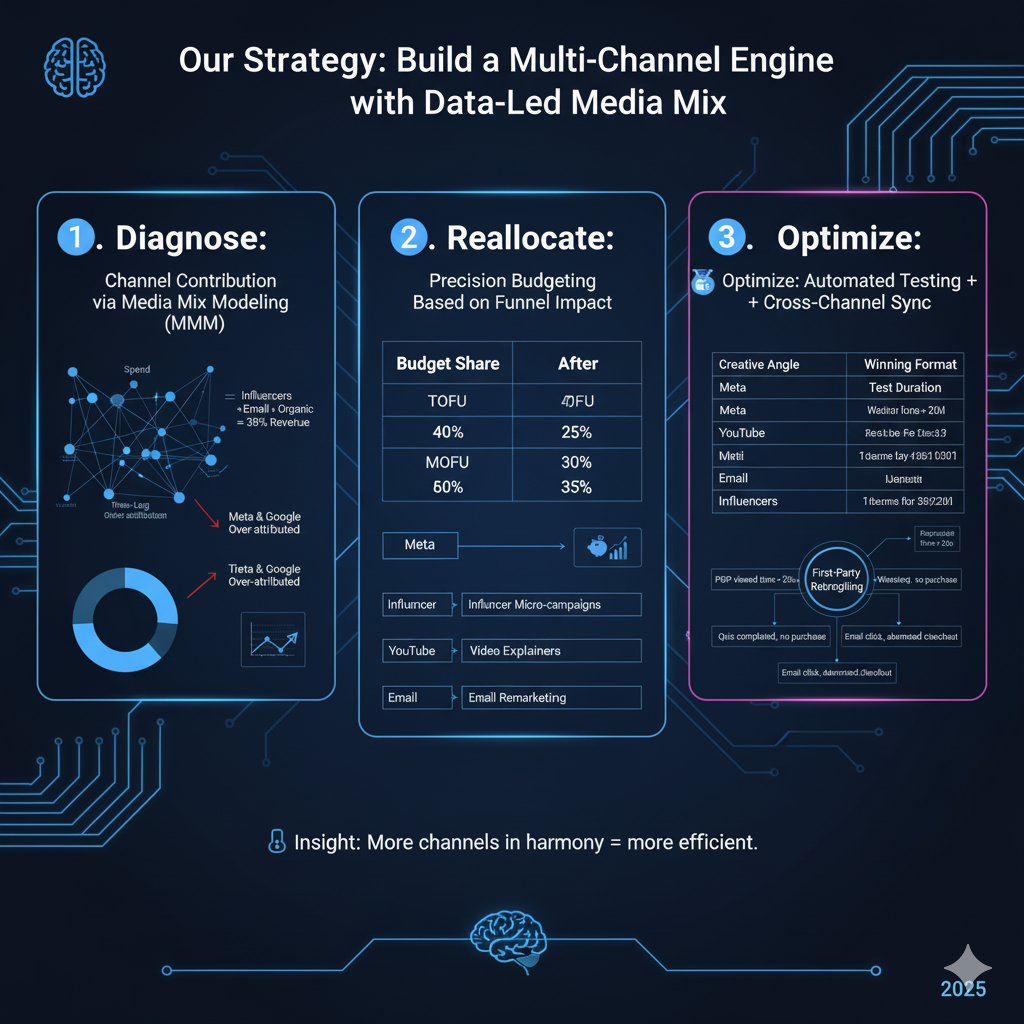
3. 🧪 Optimize: Automated Testing + Cross-Channel Sync
We deployed channel-specific creative frameworks, each tested weekly:
| Channel | Creative Angle | Test Duration | Winning Format |
| Meta | UGC + Problem-Solution | 7 days | 15s Reel with CTA |
| YouTube | Explainer + Voiceover | 10 days | 45s narrative format |
| Quiz-based journeys | Ongoing | 3-step product picker | |
| Influencers | Unboxing + Testimonial | Rolling | Instagram + YouTube Shorts |
We also built first-party retargeting segments using:
- PDP viewed time > 20s
- Quiz completed but no purchase
- Email click but abandoned checkout
All retargeting across Meta, Google, and email used coordinated offers + urgency.
The Results: 60% CAC Reduction in 90 Days
Let’s get into the numbers.
| Metric | Before Optimization | After Optimization |
| CAC | ₹1,258 | ₹489 |
| AOV | ₹1,350 | ₹1,610 |
| ROAS | 1.6x | 3.8x |
| Email Revenue Contribution | 8% | 22% |
| Influencer-Assisted Convs | <2% | 16% |
Campaign Highlights:
- 🎯 Meta CAC dropped from ₹980 to ₹620 after removing overlap and creative fatigue
- 🧪 YouTube Retargeting with 30s “how to use” videos increased CTR by 62%
- ✉️ Email open rates rose to 41% after segmenting based on quiz outcomes
- 🎥 Micro-Influencer campaigns delivered 5x ROI with cost <₹8K per creator
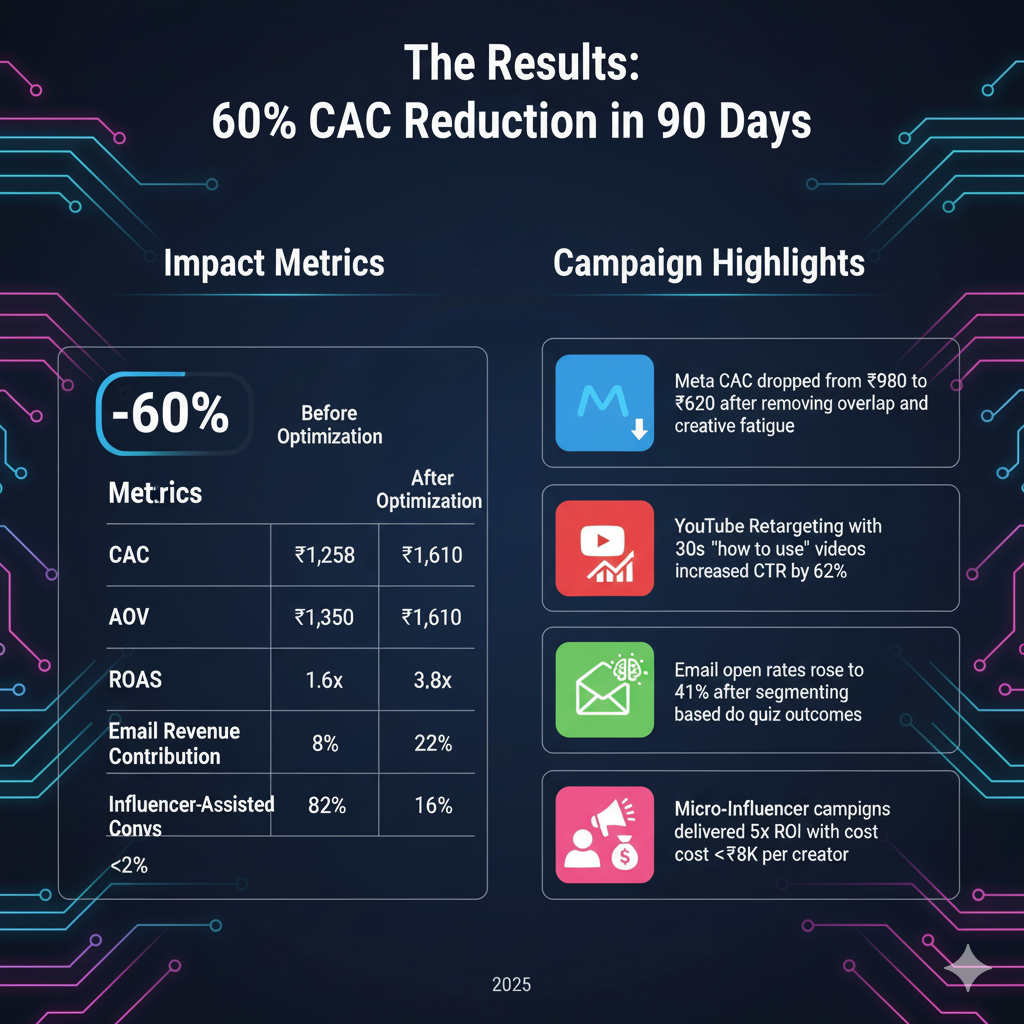
🔁 What We Learned: The Playbook for Scalable CAC Control
- Media Mix Modeling is Non-Negotiable
If you’re optimizing on what Google and Meta tell you is working, you’re being misled. - Full-Funnel Mapping = Efficient Scaling
Don’t spend ₹15L on TOFU and expect your BOFU to convert magically. - Creative Differentiation per Channel Matters
YouTube ≠ Instagram ≠ Email. Repurposing is not a strategy—customizing is. - First-Party Data Is Your Goldmine
Email, quizzes, product views, add-to-carts—build your retargeting stack here. - Collaboration Beats Channel Siloing
A channel team that works together (creative, paid, automation) scales faster with lower CAC.
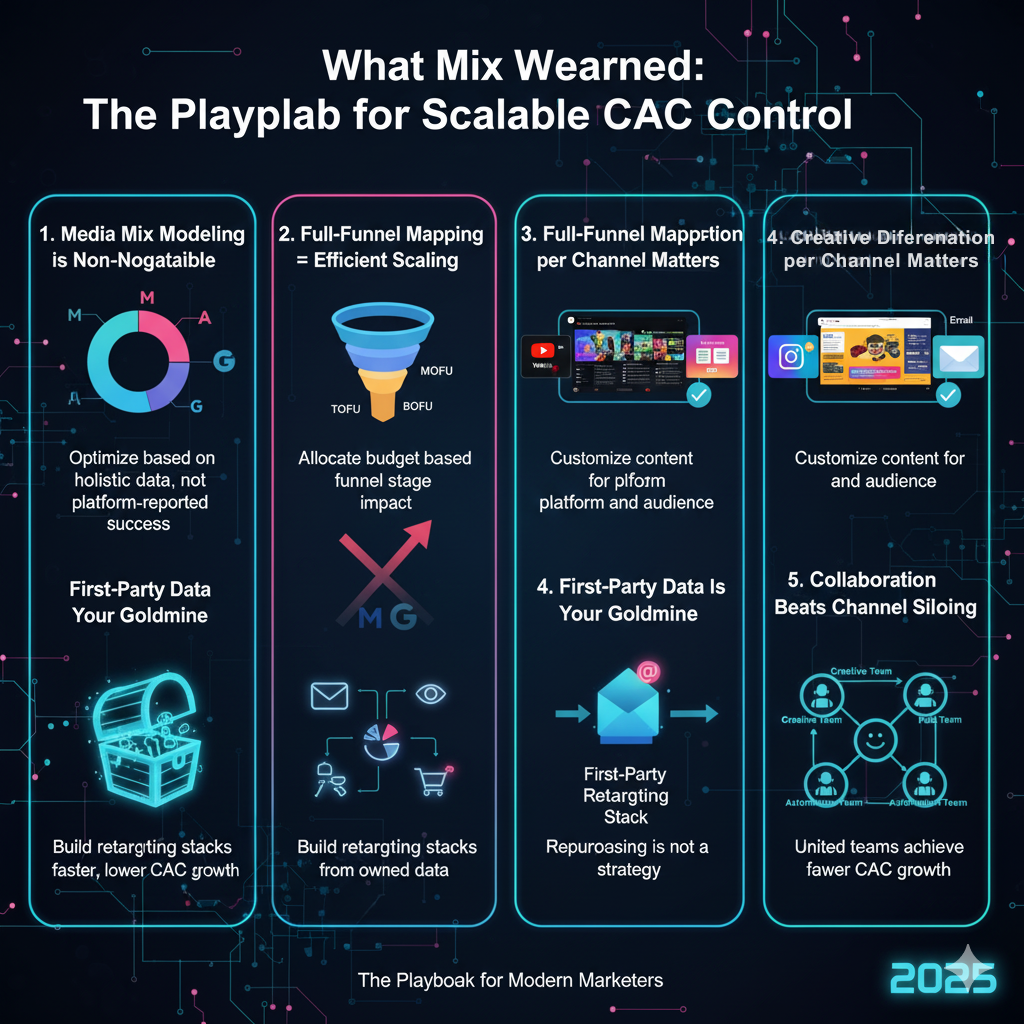
💡 Final Thought: Reducing CAC is Not a Hack. It’s a System.
You don’t reduce CAC by turning off platforms.
You reduce CAC by building a media engine that self-optimizes—across channels, funnel stages, and data inputs.
At The Brisk, this is our standard—not our success story. Our media mix strategy, creative analytics, and funnel-specific attribution help our partners scale with sanity.
Ready to Diagnose and Fix Your Rising CAC?
Let’s run a free media mix audit for your business—no fluff, just insight.
📩 [Request Your CAC Report →]
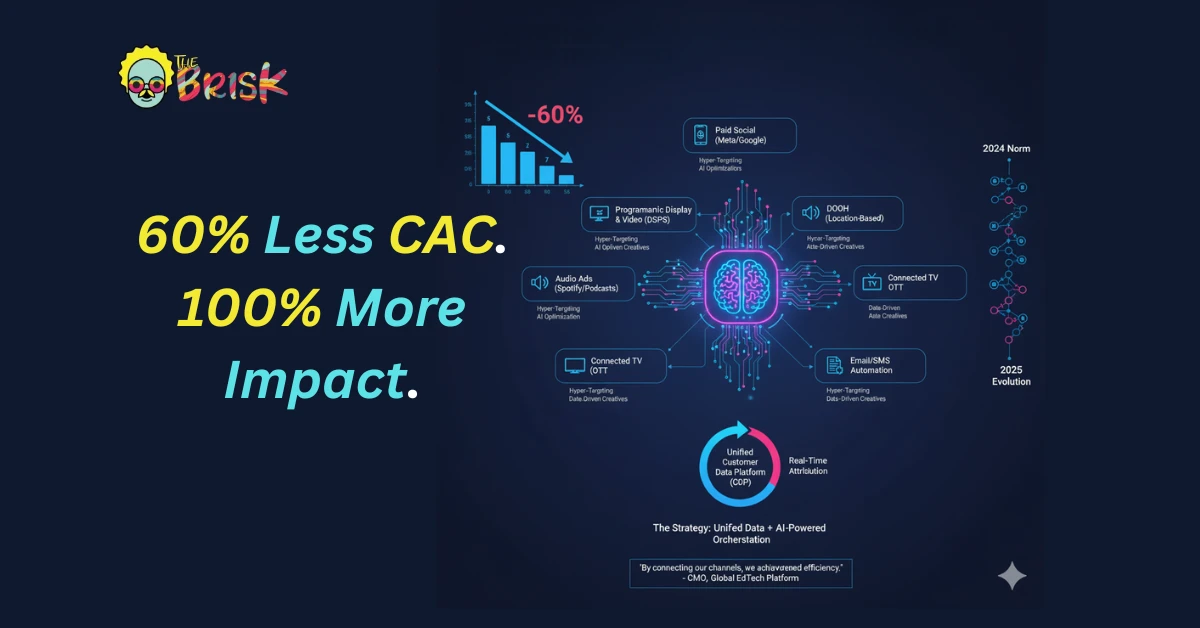

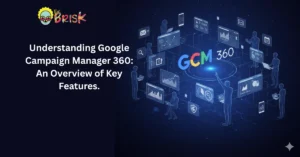
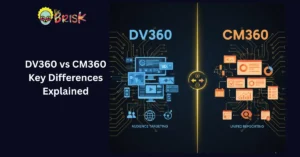
No Comments